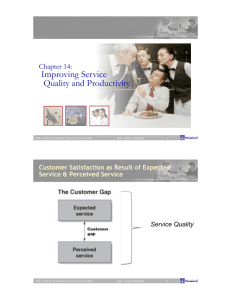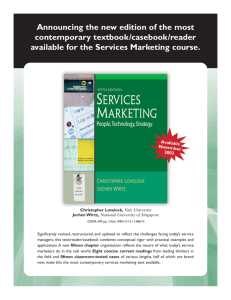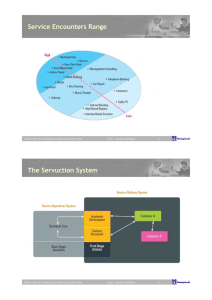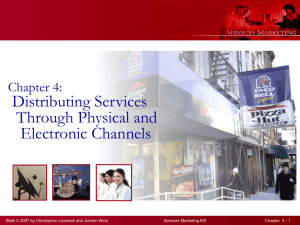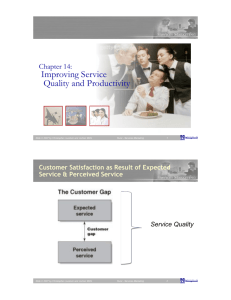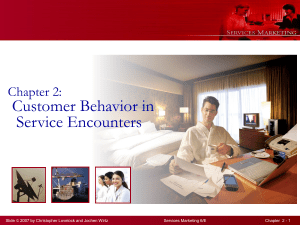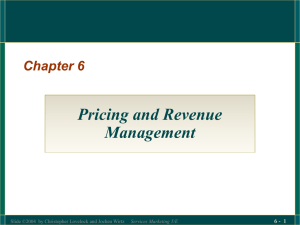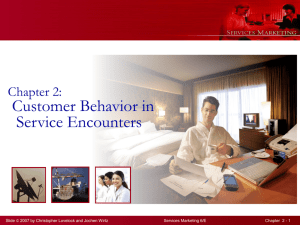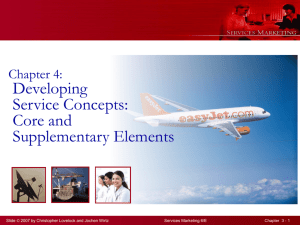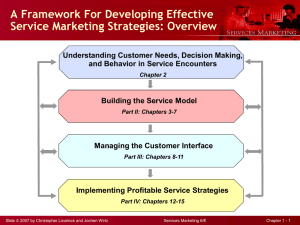Distributing Services (1)
advertisement
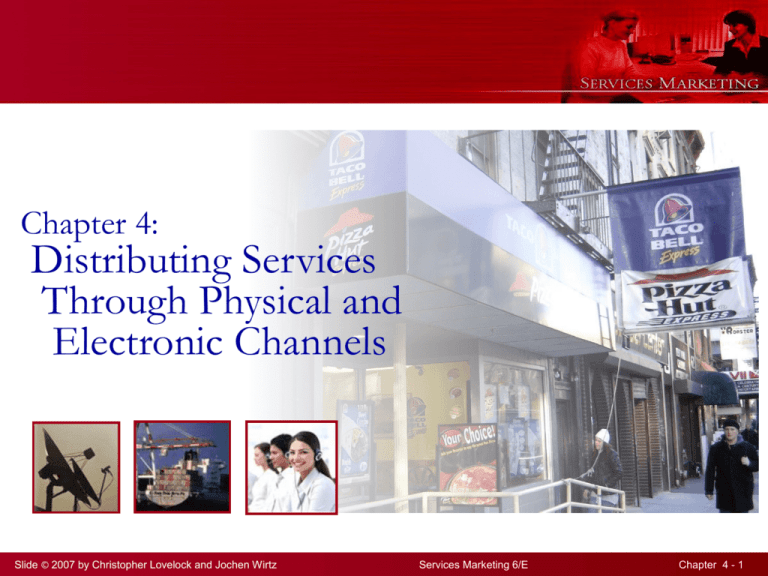
Chapter 4: Distributing Services Through Physical and Electronic Channels Slide © 2007 by Christopher Lovelock and Jochen Wirtz Services Marketing 6/E Chapter 4 - 1 Overview of Chapter 4 Distribution in a Services Context Determining Type of Contact: Options for Service Delivery Place and Time Decisions Delivering Services in Cyberspace The Role of Intermediaries The Challenge of Distribution in Large Domestic Markets Distributing Services Internationally Slide © 2007 by Christopher Lovelock and Jochen Wirtz Services Marketing 6/E Chapter 4 - 2 Distribution in a Services Context Slide © 2007 by Christopher Lovelock and Jochen Wirtz Services Marketing 6/E Chapter 4 - 3 Applying the Flow Model of Distribution to Services Distribution embraces two interrelated elements: Information and promotion flow To get customer interested in buying the service Negotiation flow To sell the right to use a service Slide © 2007 by Christopher Lovelock and Jochen Wirtz Services Marketing 6/E Chapter 4 - 4 Distinguishing between Distribution of Supplementary and Core Services Distribution relates to both core services and supplementary services Core services for people processing and possession processing services require physical locations Core services for mental stimulus processing and information processing can be distributed electronically Supplementary services can be tangible or intangible in nature; latter can be distributed widely and costeffectively via nonphysical channels Telephone Internet Slide © 2007 by Christopher Lovelock and Jochen Wirtz Services Marketing 6/E Chapter 4 - 5 Determining Type of Contact: Options for Service Delivery Slide © 2007 by Christopher Lovelock and Jochen Wirtz Services Marketing 6/E Chapter 4 - 6 Distribution Options for Serving Customers Customers visit service site Convenience of service factory locations and operational schedules important when customer has to be physically present Service providers go to customers Unavoidable when object of service is immovable More expensive and time-consuming for service provider Service transaction is conducted remotely Achieved with help of logistics and telecommunications Slide © 2007 by Christopher Lovelock and Jochen Wirtz Services Marketing 6/E Chapter 4 - 7 Channel Preferences Vary among Customers For complex and high-perceived risk services, people tend to rely on personal channels Individuals with greater confidence and knowledge about a service/channel tend to use impersonal and selfservice channels Customers with social motives tend to use personal channels Convenience is a key driver of channel choice Slide © 2007 by Christopher Lovelock and Jochen Wirtz Services Marketing 6/E Chapter 4 - 8 Place and Time Decisions Slide © 2007 by Christopher Lovelock and Jochen Wirtz Services Marketing 6/E Chapter 4 - 9 Time of Service Delivery Traditionally, schedules were restricted Service availability limited to daytime, 40 to 50 hours a week Sunday historically considered as a rest day in Christian tradition, Saturday in Jewish tradition, and Friday in Muslim tradition Today For flexible, responsive service operations: - 24/7 service—24 hours a day, 7 days a week, around the world (Service Perspectives 4.3) Some organizations still avoid 7-day operations, for example: “Being closed on Sunday is part of our value proposition” Slide © 2007 by Christopher Lovelock and Jochen Wirtz Services Marketing 6/E Chapter 4 - 10 Delivering Services in Cyberspace Slide © 2007 by Christopher Lovelock and Jochen Wirtz Services Marketing 6/E Chapter 4 - 11 Delivering Services in Cyberspace Developments in telecommunications and computer technology Swissôtel Hotels & Resorts - Its revamped website more than doubled online revenues within 7 months of launch - “Best Rate Guarantee” was a key driver of its success Banking and service transactions by voice telephone Courtesy of Swissotel Hotels & Resorts Slide © 2007 by Christopher Lovelock and Jochen Wirtz Services Marketing 6/E Chapter 4 - 12 Service Delivery Innovations Facilitated by Technology Technological Innovations Development of “smart” mobile telephones and PDAs as well as Wi-Fi high-speed Internet technology that links users to Internet from almost anywhere Voice-recognition technology Websites Smart cards - Store detailed information about customer - Act as electronic purse containing digital money Increase accessibility of services Deliver right information or interaction at right time Create and maintain up-to-date real-time information Slide © 2007 by Christopher Lovelock and Jochen Wirtz Services Marketing 6/E Chapter 4 - 13 e-Commerce: Move to Cyberspace (1) Internet facilitates 5 categories of “flow” Information Negotiation Service Transactions Promotion Electronic channels offer complement/alternative to traditional physical channels Convenience (24-hour availability, save time, effort) Ease of obtaining information online and searching for desired items Better prices than in many bricks-and-mortar stores Broad selection Slide © 2007 by Christopher Lovelock and Jochen Wirtz Services Marketing 6/E Chapter 4 - 14 e-Commerce: Move to Cyberspace (2) Recent Developments link Websites, customer management (CRM) systems, and mobile telephony Integrating mobile devices into the service delivery infrastructure can be used as means to: Access services Alert customers to opportunities/problems Update information in real time Slide © 2007 by Christopher Lovelock and Jochen Wirtz Services Marketing 6/E Chapter 4 - 15 Role of Intermediaries Slide © 2007 by Christopher Lovelock and Jochen Wirtz Services Marketing 6/E Chapter 4 - 16 Splitting Responsibilities For Supplementary Service Elements As created by originating firm Core (Fig 4.3) As enhanced by distributor + Core product As experienced by customer = Supplementary services Core Total experience and benefits Challenges for original supplier Act as guardian of overall process Ensure that each element offered by intermediaries fits overall service concept Slide © 2007 by Christopher Lovelock and Jochen Wirtz Services Marketing 6/E Chapter 4 - 17 Franchising (1) Popular way to expand delivery of effective service concept Franchising is a fast growth strategy, when Resources are limited Long-term commitment of store managers is crucial Local knowledge is important Fast growth is necessary to preempt competition Study shows significant attrition rate among franchisors in the early years of a new franchise system One-third of all systems fail within first 4 years Three-fourths of all franchisors cease to exist after 12 years Slide © 2007 by Christopher Lovelock and Jochen Wirtz Services Marketing 6/E Chapter 4 - 18 Franchising (2) Disadvantages of franchising Some loss of control over delivery system and, thereby, over how customers experience actual service Effective quality control is important yet difficult Conflict between franchisees may arise especially as they gain experience Slide © 2007 by Christopher Lovelock and Jochen Wirtz Services Marketing 6/E Chapter 4 - 19 Dunkin’ Brands Distributes Its Branded Service Concepts through Franchisees (Fig 4.4) Dunkin’ brands: Dunkin’ Donuts (coffee and backed goods), Baskin Robbins (ice cream), Togo’s (sandwiches) Slide © 2007 by Christopher Lovelock and Jochen Wirtz Services Marketing 6/E Chapter 4 - 20 The Challenge of Distribution in Large Domestic Markets Slide © 2007 by Christopher Lovelock and Jochen Wirtz Services Marketing 6/E Chapter 4 - 21 The Challenge of Distribution In Large Domestic Markets Marketing services (i.e., physical logistics) face challenges due to: Distances involved (geographic areas) Existence of multiple time zones Multiculturalism (especially, immigrants and indigenous people) Differences in laws and tax rates Large U.S. companies counter this by: Targeting specific market segments Seeking out narrow market niches Q: Choose any one service that may be classed as targeting a “niche market” and list the various consequences, both positive and negative of targeting such a niche in a certain location Slide © 2007 by Christopher Lovelock and Jochen Wirtz Services Marketing 6/E Chapter 4 - 22 Distributing Services Internationally Slide © 2007 by Christopher Lovelock and Jochen Wirtz Services Marketing 6/E Chapter 4 - 23 How Service Processes Affect International Market Entry People processing services require direct contact with customers Export service concept - Acting alone or in partnership with local suppliers - For example, e.g., chain restaurants, hotels, car rental firms Import customers - Inviting customers from overseas to firm’s home country - For example, holding academic conferences. Transport customers to new locations - Passenger transportation (air, sea, rail, road) Slide © 2007 by Christopher Lovelock and Jochen Wirtz Services Marketing 6/E Chapter 4 - 24 Barriers to International Trade in Services Passage of free-trade legislation is important facilitator of transnational operations Notable developments: Trade Blocs. Examples? Despite efforts of WTO, operating in international markets still difficult Restrictions on international airline operating rights Administrative delays Limited availability of work permits Heavy taxation Legal restrictions Lack of broadly agreed accounting standards Cultural issues Slide © 2007 by Christopher Lovelock and Jochen Wirtz Services Marketing 6/E Chapter 4 - 25 Factors Favoring Adoption of Transnational Strategies Transnational strategy involves integration of strategy formulation and its implementation across all countries in which company elects to do business Market drivers Common customer needs across countries Corporate customers seek to standardize and simplify suppliers used in different countries—ad agencies, logistics suppliers, Big 4 accounting firms Fig 4.6 Courtesy of DHL International Ltd. Slide © 2007 by Christopher Lovelock and Jochen Wirtz Services Marketing 6/E Chapter 4 - 26 Summary of Chapter 4: Distributing Services (1) Distribution relates to both core and supplementary services and embraces three interrelated elements Information and promotion flow, negotiation flow, product flow Channel preferences vary among customers, options include: Customers visit the service site Service providers go to their customers Service transaction is conducted remotely Place and time decisions include where services should be delivered in bricks-and-mortar context, when it should be delivered Delivery in cyberspace is facilitated by technology and e-commerce allows 24-hour delivery, saving time and effort Intermediaries play roles in distributing services Franchising brings both advantages and disadvantages to the firm Slide © 2007 by Christopher Lovelock and Jochen Wirtz Services Marketing 6/E Chapter 4 - 27 Summary of Chapter 4: Distributing Services (2) Service processes affect international market entry differently There are different drivers of globalization of services and their distribution Market drivers Competition drivers Technology drivers Cost drivers Government drivers People processing services, possession processing services, and information-based services impact five groups of drivers differently Slide © 2007 by Christopher Lovelock and Jochen Wirtz Services Marketing 6/E Chapter 4 - 28
